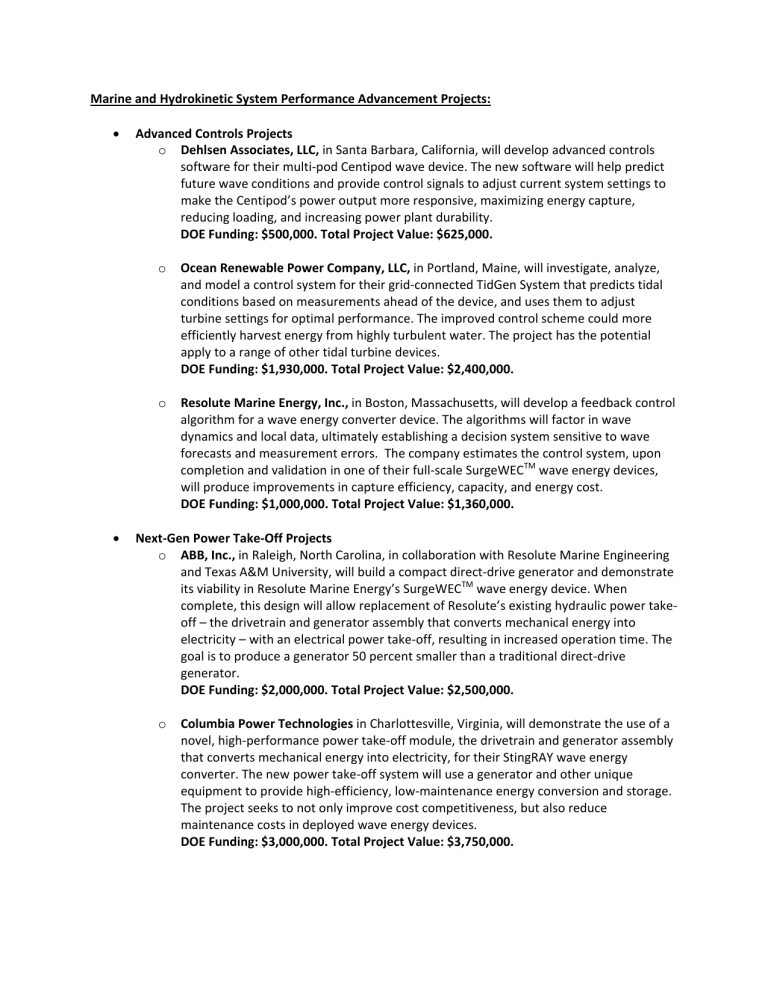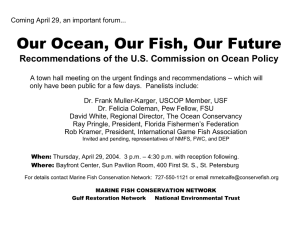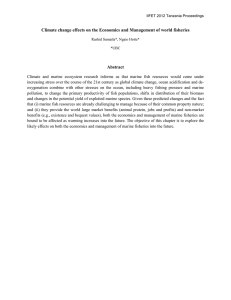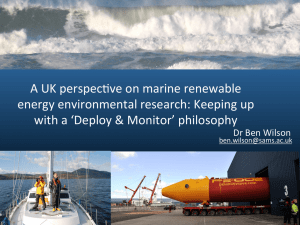
Marine and Hydrokinetic System Performance Advancement Projects: Advanced Controls Projects o Dehlsen Associates, LLC, in Santa Barbara, California, will develop advanced controls software for their multi‐pod Centipod wave device. The new software will help predict future wave conditions and provide control signals to adjust current system settings to make the Centipod’s power output more responsive, maximizing energy capture, reducing loading, and increasing power plant durability. DOE Funding: $500,000. Total Project Value: $625,000. o Ocean Renewable Power Company, LLC, in Portland, Maine, will investigate, analyze, and model a control system for their grid‐connected TidGen System that predicts tidal conditions based on measurements ahead of the device, and uses them to adjust turbine settings for optimal performance. The improved control scheme could more efficiently harvest energy from highly turbulent water. The project has the potential apply to a range of other tidal turbine devices. DOE Funding: $1,930,000. Total Project Value: $2,400,000. o Resolute Marine Energy, Inc., in Boston, Massachusetts, will develop a feedback control algorithm for a wave energy converter device. The algorithms will factor in wave dynamics and local data, ultimately establishing a decision system sensitive to wave forecasts and measurement errors. The company estimates the control system, upon completion and validation in one of their full‐scale SurgeWECTM wave energy devices, will produce improvements in capture efficiency, capacity, and energy cost. DOE Funding: $1,000,000. Total Project Value: $1,360,000. Next‐Gen Power Take‐Off Projects o ABB, Inc., in Raleigh, North Carolina, in collaboration with Resolute Marine Engineering and Texas A&M University, will build a compact direct‐drive generator and demonstrate its viability in Resolute Marine Energy’s SurgeWECTM wave energy device. When complete, this design will allow replacement of Resolute’s existing hydraulic power take‐ off – the drivetrain and generator assembly that converts mechanical energy into electricity – with an electrical power take‐off, resulting in increased operation time. The goal is to produce a generator 50 percent smaller than a traditional direct‐drive generator. DOE Funding: $2,000,000. Total Project Value: $2,500,000. o Columbia Power Technologies in Charlottesville, Virginia, will demonstrate the use of a novel, high‐performance power take‐off module, the drivetrain and generator assembly that converts mechanical energy into electricity, for their StingRAY wave energy converter. The new power take‐off system will use a generator and other unique equipment to provide high‐efficiency, low‐maintenance energy conversion and storage. The project seeks to not only improve cost competitiveness, but also reduce maintenance costs in deployed wave energy devices. DOE Funding: $3,000,000. Total Project Value: $3,750,000. o Ocean Renewable Power Company, LLC, in Portland, Maine, will develop and test components—including bearings, couplings, and a subsea electrical generator—for an advanced power take‐off system,, the drivetrain and generator assembly that converts mechanical energy into electricity, suitable for wave, tidal, and current energy devices. In addition, the company will conduct studies to measure the component and system performance benefits and to identify how best to incorporate these components into their existing turbine technologies, which include tidal, riverine, and ocean current applications. This project seeks to develop a common set of components for wave, tidal, and current energy devices that will improve their power‐to‐weight ratio and availability. DOE Funding: $3,000,000. Total Project Value: $4,500,000. Advanced Structures Projects o Ocean Energy USA, LLC, in Sacramento, California, will develop and conduct wave‐tank testing on a cost‐effective hull design for their deep‐water wave energy device. This project aims to improve the power‐to‐weight ratio of the device and accelerate the commercial deployment of this technology. DOE Funding: $1,000,000. Total Project Value: $1,250,000. o Ocean Power Technologies, Inc., in Pennington, New Jersey, will work on developing the float and spar – or cylindrical body – components of their PowerBuoy wave energy converter. These two components account for 50 percent of the device’s mass, so improving materials, manufacturability, and durability of the float and spar could reduce the cost of energy and significantly improve the device’s power‐to‐weight ratio. This work will make the PowerBuoy more reliable and marketable. DOE Funding: $1,000,000. Total Project Value: $1,250,000. Marine and Hydrokinetic Environmental Projects: Environmental Monitoring of Marine and Hydrokinetic Projects o University of Maine, in Orono, Maine, will use data on the interactions of fish with ORPC’s TidGen tidal turbine to predict the probability of fish encountering marine and hydrokinetic devices. Building on data gathered since 2010—which established baseline patterns of fish distribution at the turbine’s location—this project will provide post‐ deployment data for comparison, improve techniques for distinguishing between fish species using undersea acoustic sensors, and implement a probability‐of‐ encounter model. This work will aid assessment of possible effects of marine and hydrokinetic devices on species or groups of species, and improve understanding of potential longer‐ term effects of a hydrokinetic device on local fish populations. DOE Funding: $394,000. Total Project Value: $494,000. o Electric Power Research Institute, Inc., in Palo Alto, California, will assess how electromagnetic fields generated by undersea electricity transmission may affect marine species. To simulate the conditions that would exist around a transmission cable connected to a hydrokinetic energy device, researchers will observe fish behavior around a high‐voltage cable connecting the cities of San Francisco, California, and Pittsburg, California. The project will investigate whether the electromagnetic fields around the power cable alter the behavior or path of fish along a migratory corridor and find out whether the electromagnetic fields help guide migratory movements or create obstacle to migration. DOE and BOEM Funding: $400,000. Total Project Value: $712,000. o Oak Ridge National Laboratory, in Oak Ridge, Tennessee, will quantify the distribution, behavioral response, and general patterns of fish movement around an operating tidal energy turbine. The research team will conduct an analysis of individual fish movements using previously unanalyzed sonar data collected at Verdant Power’s Roosevelt Island Tidal Energy Project, located in the East River near Manhattan. This study will provide the industry with a complete analysis of fish interaction data at a full‐size turbine that developers and regulators can use to estimate the likelihood of encounter and injury at tidal and riverine sites. The tools refined in this study will be widely applicable to other sites and conditions, and the results from this study will be used to refine estimates of potential effects, design mitigation to minimize impacts, and develop monitoring protocol. DOE Funding: $95,000. Total Project Value: $132,000. o University of Washington, in Seattle, Washington, will characterize the behavioral responses of killer whales, harbor porpoises, and fin‐footed marine mammals, such as seals, sea lions, walruses, to the sounds produced by tidal turbines. This project will produce a description of the temporal and spatial variation in sound produced by a pair of tidal turbines deployed in Puget Sound, and demonstrate the effectiveness of wildlife observation techniques around marine renewable energy projects. DOE Funding: $400,000. Total Project Value: $500,000. o Oregon State University, in Corvallis, Oregon, will measure changes in sound levels from the installation and operation of a wave energy converter in the coastal ocean, including comparison with other natural and man‐made sources near the project site. This project will be used to develop a long‐term “noise budget” for the area that will serve as a baseline for future assessments of noise impacts related to resource development in the region. Further, observations of vocally active marine mammals and fish at the project site will be used to assess behavioral responses to the construction and operation of the wave energy converter. DOE Funding: $150,000. Total Project Value: $188,000. o Oregon State University, in Corvallis, Oregon, will characterize fish communities near wave energy deployments in Oregon and compare them to adjacent natural reefs and quantify differences in fish attraction between an energy‐producing wave device and a non‐energy‐producing analysis platform anchored in the same habitat. By understanding these impacts, device developers and regulators can potentially make decisions regarding device or mooring design to minimize interactions with fish. DOE Funding: $398,000. Total Project Value: $500,000. o Florida Atlantic University, in Boca Raton, Florida, will characterize the electromagnetic field emissions at the Navy’s South Florida Ocean Measurement Facility — an in‐water test facility that consists of a number of bottom‐mounted sensors for measuring and characterizing acoustic and electromagnetic signatures of submarines—as representative of a location where marine and hydrokinetic devices may be sited. This analysis will then be used to monitor and assess how electromagnetic fields affect the behavior of local marine species and sea‐floor communities. The project will establish a database of field measurements, and use it to assess the potential ecological impacts of electromagnetic fields on individual organisms, populations, and communities in the vicinity. DOE Funding: $400,000. Total Project Value: $500,000. Projects Analyzing Environmental Effects of Surrogate Technologies o H.T. Harvey & Associates, in Los Gatos, California, will evaluate the potential for marine and hydrokinetic devices to attract marine wildlife and fish. The goal of this research is to evaluate the nature, intensity, and frequency of potential interactions between marine and hydrokinetic device surrogates and fish and invertebrate communities, helping inform permitting and licensing policies. This study will analyze similar marine structures—such as offshore open‐ocean fish farms, oil platforms, moored buoys, and artificial reefs built for recreational fisheries—in tropical, subtropical and temperate western U.S. and Hawaiian coastal waters. BOEM Funding: $75,000. Total Project Value: $75,000. o Vantuna Research Group, in Hermosa Beach, California, will conduct a review of existing literature related to the impacts of electromagnetic fields associated with technologies similar to marine and hydrokinetic devices, and evaluate potential effects on specific species or groups. The goal of the project is to identify important knowledge gaps regarding the potential interaction of fish with marine and hydrokinetic energy devices, and develop recommendations for future studies that will help address these gaps. BOEM Funding: $70,000. Total Project Value: $70,000.



